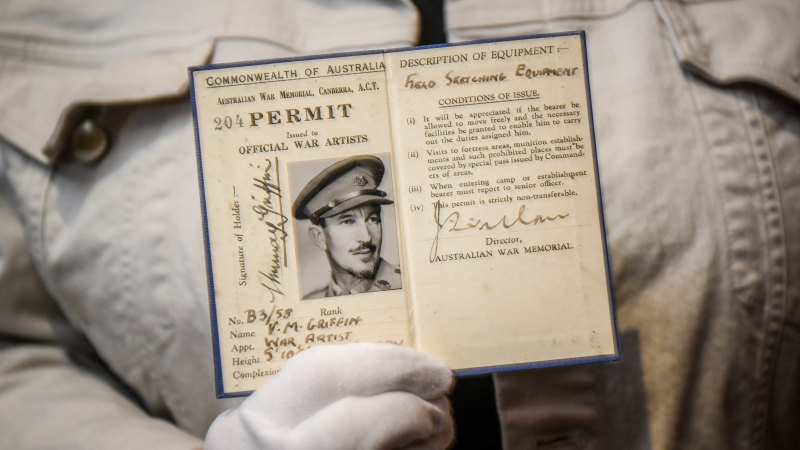‘Humanity among chaos’: War artist’s works and relics donated to Shrine of Remembrance

Save articles for later
Add articles to your saved list and come back to them any time.
For many years, war artist Murray Griffin kept a small wooden sculpture hanging on the wall of the stairs leading up to his studio in the Melbourne suburb of Eaglemont.
It depicts the agony of an injured Malay woman brought into St Andrew’s Cathedral during the Japanese invasion of Singapore.
Murray Griffin jnr with the sculpture that artist Murray Griffin carved from a chair leg, and Kate Griffin with his war artist permit.Credit: Justin McManus
The cathedral became a makeshift hospital, and Griffin was there to document history.
It is believed that during Griffin’s subsequent three years as a prisoner of war in the Changi camp in Singapore, he carved the sculpture out of a chair leg.
Griffin’s grandson, also named Murray Griffin, said the artist, who died in 1992, kept the sculpture on prominent view. “It was a daily reminder of all the suffering people had endured,” he said.
The sculpture is among more than 50 artworks, personal items and photographs that Murray Griffin jnr, with the support of his siblings Penny, Julia and Kate, has donated to Melbourne’s Shrine of Remembrance.
Changi bunk house depicts POW friends gathering in Murray Griffin’s quarters in Singapore. Griffin’s head is at the top of the piece, on the right.
They include Griffin’s war artist permit, a Japanese identity disc from Changi and a necklace made of Malayan coins.
An oil painting depicts Allied soldiers firing at Japanese troops invading the Malay Peninsula in tanks.
To paint the piece Changi bunk house, Griffin used lampblack, a form of soot, to depict a group of Allied prisoners of war sitting around a table amid bunks and hanging laundry.
Murray Griffin jnr says it “shows the efforts of the prisoners to retain their humanity and their comradeship in very inhumane conditions”.
Detail from a self-portrait painted before Griffin left to serve overseas.
He also singles out a self-portrait Griffin painted before he left to serve overseas, which he finds a powerful symbol of those who served. “It was painted before an intense period of suffering. They went off, in their youth, and experienced terrible things.”
Murray Griffin jnr is donating the collection to the Shrine following the death last year of his father, the artist’s son Garry Griffin.
The works already hang in major galleries and at the Australian War Memorial, which holds Griffin’s portrait of another Australian prisoner of war, the surgeon Sir Edward “Weary” Dunlop.
Murray Griffin jnr said he was “thrilled and honoured” that a rotating selection of the new Griffin donations will be on permanent display in the Shrine’s World War II gallery.
Griffin’s government war artist permit.Credit: Justin McManus
His sister Kate Griffin said she was proud of her grandfather, who was also known as Vaughan Murray Griffin. She said he was a loving and much-loved man.
She said his work showed an amazing ability to look outward, at others, despite what he might be going through in the war.
A war artist’s role, she said, was “to pick out the humanity among the chaos, and remind us of the struggles of war, but also to point out the resilience and the triumph of the human spirit”.
Shrine curator Neil Sharkey said war artists “have integrated a sensory and emotional dimension to our understanding of warfare that isn’t readily incorporated into written histories, photography or documentary film.
“Murray Griffin is unique among Australia’s official war artists in that he is the only one to have shared the experiences of the 22,000 Australian prisoners of war captured by the Japanese in the Pacific during the Second World War.
“His work celebrates the valour of the men who battled the Japanese in Malaya and Singapore, before their capture, and their steadfastness, endurance and ingenuity afterwards.”
Griffin’s work is part of the Shrine’s 11 Days of Remembrance, running until Remembrance Day on November 11, focusing on how poetry, literature, music and art express the impact of military conflict.
Start the day with a summary of the day’s most important and interesting stories, analysis and insights. Sign up for our Morning Edition newsletter.
Most Viewed in National
From our partners
Source: Read Full Article



